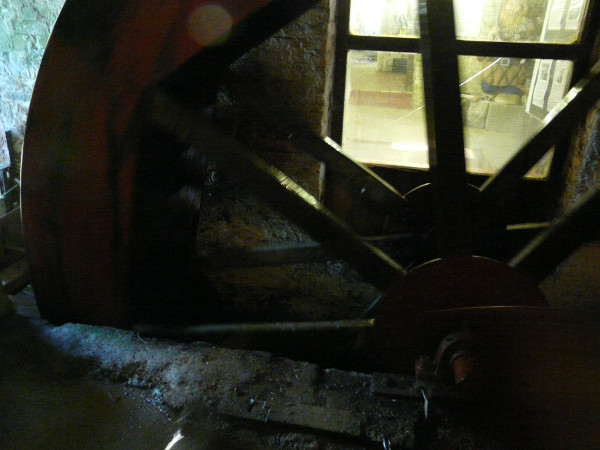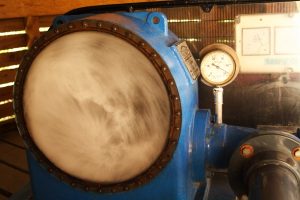This was an interesting diversion. I was asked a couple of years ago if I would take a look at a watermill in Bourne (Lincolnshire) and see what the problem was with the generator. Interesting – how often do you get asked to play with a watermill?
Before I go any further it’s useful to reflect on what I found out when experimenting with this water mill. The first revelation was that the mill could be run without a load on it. By observation it was quickly apparent that the maximum wheel speed was regulated by the water volume over the sluice, the size of the buckets, and the water exiting through a culvert. This meant that as far as electrical generation was concerned its behaviour was closer to that of a solar panel than a wind turbine. Wind turbines need a load at all times or the speed will increase to the point of blade destruction, but with this water wheel this was not the case. This affected the choice of grid inverter and prevented any worries when there was a mains power cut. The loss of mains power would mean the inverter would shut down and remove the electrical load on the wheel.
On initial inspection some quite old and suspect technology had been used and this proved quite inefficient. A huge ratio gearbox (140:1) was used to direct drive a 1 hp 3-phase motor, and with the addition of capacitors this did generate some power. The whole thing was very noisy and the gearbox was very warm, indicating that power was being lost in the drive train. This generator was also not self-starting and needed to be manually energised to start producing electricity.
Generating electricity with a watermill, part 1: investigations into gearing.
The question asked by Jim (one of the trust members) was “can we generate some usable power that can be fed into the grid?” The answer was “ yes but the exact method will take some experiment.”
From my wind turbine pioneering days I am familiar with brushless permanent magnet generators (see Wind and Solar Electricty), 3-phase rectifiers, and belt drives. So the initial task was to find a suitable generator and luckily Manor Solar (Peterbourough) had an old Windsave generator laying on the shelf looking forlorn. You may remember these as those small turbines that were bolted on the end of houses in exactly the wrong place to get turbulence-free wind, hence you don’t see them anymore. However, the generators are 3-phase, brushless permanent magnet alternators producing about 250v at 1000 watts depending on the rotational speed (RPM). Good news.
I ask the readers for some forbearance on the quality of some of the following photos as they are captured from my videos, hence not up to digital camera standard – still, they show the concepts. The first photo is a Windsave alternator on a home-made belt-adjusting mounting plate with a belt pulley fitted to the shaft.

Windsave alternator.
Our second visit to the mill was so that we could cobble together a belt drive from the existing gearbox, and then drive the Windsave alternator with this belt. An 850 watt heating element taken from a storage heater was wired in circuit as an electrical load, and then we set the wheel spinning to see what happened. We changed the ratios in this experimental belt drive several times in an attempt to find the best overall wheel to generator ratio.
The upshot of these experiments was an idea of the overall gearing required, the expected output, and the fact that there was something wrong with the wheel as the power was not even. On each rotation the power fluctuated leading us to think there was a problem with one or more paddles. We left this to others to sort out.

Gearing test.
A replacement old heavyweight gearbox of 30:1 was found at RH Rundle in New Bolingbroke, and very helpful and interested they were. This was an educated guess at the ratio knowing that this could be finely tuned with the belt ratios between gearbox and alternator.

Gearbox and drive pulley.
Between visit 2 and 3 Jim made a mount for the gearbox using the existing direct coupling from the 2-inch wheel shaft. On our return we could roughly fix the generator sufficiently to take the strain of the belt drive and do further tests.

Load experiments.
We used fenner taper lock pulleys and bushes to help the experiments with the changing of the various pulley sizes to get an overall drive ratio. These pulleys were from our experimental stock so a wide variation was available at no initial cost. The photo below – ‘belt drive from gearbox’ shows the fenner taper lock bush in place within a pulley. Tightening the grub screws locks the unit on to the shaft.
Generating electricity with a watermill, part 2: gearing and output.
So on to the commissioning, Jim made a generator mounting to line up with the replacement gearbox and fitted the pulleys and belts. Giving everything a fine coat of paint, and made up some guards for unwary fingers. He selected M section belts to reduce the bending friction and prevent losses in power in this part of the drive train. A flat multi-groove belt would be even better and this may be a modification once things have settled down. However, alignment is more critical with this type of belt.

Belt drive from gearbox.
Now we had to select a suitable grid inverter. The DC volts from the Windsave generator would be around 250v with a load, and we were expecting about 500 watts generation, but it may have been more. The inverter has to match the volts from the generator and it is vital that the generator cannot produce volts in excess of the inverter maximum
Here is a photo of the inverter specifications, you will see that max DC volts is 700 which was not possible with this wheel and gearing.

SMA specifications.
The other factor was public understanding as this wheel is in Baldock’s Mill museum, so because of this we chose an SMA HF2000 (and because it was available second-hand). These inverters have a large display showing generation and output and suitable symbols to aid easy comprehension.

SMA HF inverter.
When everything was wired up, the sluice gate opened and the inverter switched on, we were generating power. The inverter took some time to settle down and take on its new role as a water wheel inverter, not a solar one as was its previous duty. Output at the moment is expected to be around 5 Kwh per 24 hours, a significant contribution to background electrical consumption.

Water wheel schematic.
Here is the final video of this 3-part series showing the system being commissioned.
Generating electricity with a watermill, part 3: the grid tie working.
I hope you find this as interesting as I did.
My video channel is here with lots of wind and solar ideas and experiments:
https://www.youtube.com/user/TheInfoworks/videos
Andy Reynolds
Practitioner in lowimpact living and author of Wind and Solar Electricity.



4 Comments
Very Interesting.
Do you anticipate any potential issues with that gearbox and generator due to overspeed? Although fit for its original purpose, what about an upgrade of that sluice gate perhaps with some smart control linked to the generator output?
I’ve got a bit of information on old breast-wheel design if you are interested.
Andrew
[email protected]
We are looking at a disused water mill to convert to a home, it doesn’t have a wheel at present, but has a fast flowing leet that runs through. We’re looking at sustainable green energy and wondering if a conversion to water power would be efficient and even possible. We have researched turbines, but they seem very expensive and not necessarily the best for a 3 storey dwelling as they produce more power than we could ever need or use. Have read your article and what seems like an amazing idea, has lots of complex implications. Also research has thrown up lots of hurdles to jump ie planning, EA permissions etc. We are also wondering in this green climate if help to fund these are out there? We are looking in the Rydale North Yorkshire area. Any tips, ideas or suggestions please? Thank you. Ali.
Hi, from my experience a tradition water wheel is noisy, damp and not very efficient. You can hear the noise in the video, bit like a steam engine. They are also expensive to build. Pelton turbines make life much easier, use less water, and can have some automatic controls. A I kW generator connected to batteries would be more than enough for your humble needs. Talk to Hugh Piggot of Scoraig wind for much more info, cheers
I recently stumbled upon an intriguing traditional watermill generator blog, and it got me thinking about innovative solutions. Exploring options at Wildkamp could be the next step in turning these ideas into reality.